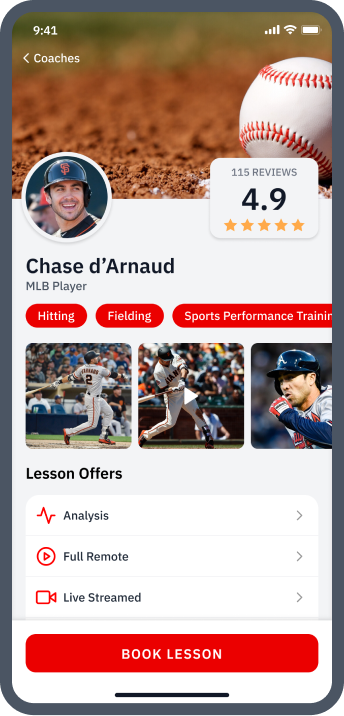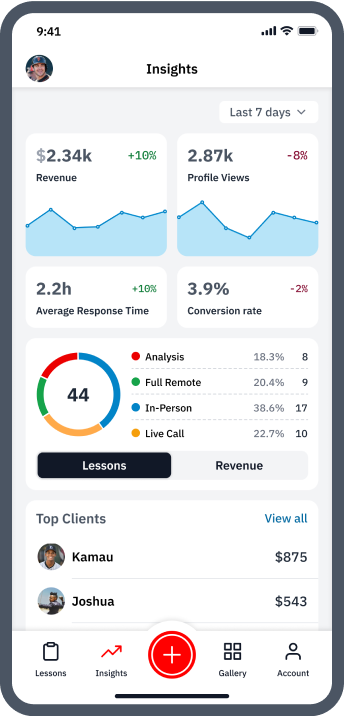8 Psychology Lessons for Baseball and Softball Coaches Looking to Grow Their Social Media | With Real Examples

Why do people post on social media? And how does sharing content affect us psychologically?
If you’re a baseball or softball coach or company launching your brand on social media, you should know that there’s more to growing on social media than marketing best practices.
There’s also psychology behind social media and how we use it – which you, as a coach, can learn to leverage.
Knowing what motivates people on social, why we respond to posts in a particular way, and what prompts us to share content with others will be indispensable for your baseball or softball brand.
If you want to increase your brand’s exposure, then keep reading for eight tips on using psychology for social media.
Here’s the overview:
- Sharing content
- Building trust
- Visual Learning
- Choosing Color
- Being Positive
- Relating to Personal Experience
- Using Reciprocity
- Leveraging FOMO
We’ll tackle them one by one in detail and provide a baseball or softball related example for each.
Let’s gooo!
Wanna grow your baseball or softball coaching brand?
Get connected to new local and online lesson clients—along with all the tools you need to scale.
Download the free app

1. Why Do Baseball and Softball People Share Content on Social Media?
Are there reasons for sharing what we do on social media? How do we decide what to share and when?
There’s more than one way to apply a psychological perspective to these questions.
The first, and one you’re probably at least familiar with, is using Maslow’s hierarchy of needs.
We'll start generic and then show you how to apply these principles to your baseball or softball brand.
Here’s a breakdown of this famous hierarchy going from bottom to top:
- Physiological needs – These are your most basic needs like food, clothing, and shelter.
When people share content on social media about a product or service that fulfills one of these needs, as 49 percent of people say they do, they’re addressing the lowest level of Maslow’s pyramid.
This can mean posting about you or your brand’s charity efforts, but it can also be stretched to include your apparel offerings or athlete diet and nutritional posts. - Safety – People often share content related to health, employment, and physical safety on social sites.
Facebook also has a “safety check” feature, which allows people to designate themselves as safe during a disaster.
Being genuine about your own fitness or mental health journeys, or keeping your followers updated on your employment roles or partnerships can all fall under this rung of the hierarchy. - Love and belonging – People desire to be liked and feel accepted, so they post and share content hoping for likes or shares.
As a brand, you can promote this need for acceptance by regularly featuring other users or followers on your social media page or profile. - Esteem – One step further than being loved and accepted is the need to be recognized and rewarded for achievements.
People share content about events in their lives, like vacations or weddings, to earn recognition for themselves. Indeed, more than 50 percent of Tweets are “me” focused in this way.
Again posting user generated content (re-posts from fans or followers about you or your brand) is a great way to recognize parents and ballplayers in your ecosystem and grow. - Self-actualization – The final level of self-actualization occurs on social media when people share content meant to inspire awe, laughter, or amusement.
Sharing the results of an online quiz boosts our ego, for instance. Posting content such as inspiration quotes, stories, and camera-facing video talks helps people feel fulfilled.

If you’re not convinced about social media posting and the hierarchy of needs, then consider the top reasons people post on social media found in a New York Times Study:
- Improving the lives of others
- Defining ourselves
- Growing and nourishing relationships
- Self-fulfillment
- Getting the word out about causes
These reasons seem to mirror the hierarchy of needs pretty closely.
So, when you’re creating content meant to help your brand grow, consider how that content might fit in with these needs.
Here's an example.
The online coaching, teaching, and baseball education platform Dominate the Diamond shares posts on Facebook that often speak to these needs.
In this post of there's below about how coaches can impact you and your growth as a player, they’re drawing on people’s desire to define and share about themselves, which leads to esteem.
And when users read comments with other’s inspirational coach stories, it will foster feelings of self-fulfillment and actualization as well.

2. How Do Baseball and Softball Coaches Build Trust on Social Media?
People are more likely to trust their peers than a brand. They’re also much more likely to trust someone they know over a stranger.
Otherwise known as social proof, marketers have been using this tactic to win over customers’ trust for decades.
The efficacy of social proof stems from being part of a larger community or feeling like you belong.
How can baseball and softball brands use social proof to establish trust on social media?
You can make the most of user-generated content (UGC).
UGC could be a review, a tutorial, or a testimonial. And while UGC may not always be of high or professional quality, it’s important to highlight this type of content on your social media to build trust.
Visual content platform Olapic showed that 76 percent of consumers find content shared by average people more convincing than advertising from brands.
Sharing content to build trust is an important psychological lesson that brands should take heed of on social media.
If you want to learn way more how to use UGC in our games, check out: The Ultimate Guide to User-Generated Content for Baseball and Softball Coaches and Entrepreneurs | With Real Examples.
Here’s a textbook example from a softball brand.
Practice Pro Pitching, a pitching school run by Abby Hanrahan, solicited UGC by hosting a contest on Instagram – one of the best ways to get users to post about your brand.
Practice Pro asked followers to film their parents doing the fastpitch windmill and post on Instagram with the hashtag #parentpitch and by tagging @practice_pro.
She then featured some of the humorously bad contest submissions on her Instagram feed, like the one below.

3. How Do Parents and Ballplayers Retain Baseball and Softball Information on Social Media?
According to the Social Science Research Network, 65 percent of the general population are visual preference learners.
This is great news for social media platforms, especially visual ones like Pinterest and Instagram.
It’s also why 42 percent of marketers report infographics as the type of content with their highest engagement rates.
If we look back at the reasons people share or create posts on social media, we’ll see:
- Improving the lives of others
- Self-fulfillment
- Spreading the word about important causes
These reasons are all related to how users perceive and retain information.
When you consider that people are on social media to learn, then you must consider how they learn.
Visual components will stand out for most people on social media. Posts that include videos, photos, infographics, or illustrations will do more to educate users who come across them; visual posts will also be more memorable.
In particular, infographics have become a useful tool for marketers who want to disseminate a lot of information in a more digestible format.
To learn all the basics of pro visuals, like employing grid lines and editing tools, don’t miss: Two Must-Haves for Baseball and Softball Coaches to Grow Their Social Media Accounts | SMART Goals and Pro Visuals.
And whether it’s for social media or offering online private lessons, you also need to know exactly which equipment guarantees high sound and video quality for your followers or clients.

4. How Do Sports Fans Respond to Color on Social Media?
First impressions are impactful, especially when it comes to marketing your brand.
Within 90 seconds, people will make up their minds about other people or products they come in contact with.
But that doesn’t mean you should scrap your chosen brand colors whenever you make a post. If your brand doesn’t use red, don’t just incorporate red into every post because you think it will catch more attention.
You just have to use colors wisely, so that they’ll send your message and fit in with your brand voice.
Here's an example from our industry.
The baseball pitch recognition and training app Applied Vision Baseball does a great job with color on their Instagram profile.
The brand’s colors are black and light blue, but they experiment with different colors in their posts. Each post features a professional player and a phrase, with a solid background color meant to match the player’s jersey.
When you navigate to their profile at @appliedvisionbaseball, the effect is stunning. A single post also stands out in users’ home feeds because the colors are vibrant, and the overall design is simple.

5. Does Emotion Play into Coaches' Social Media Posts?
Posts that evoke emotional responses are more likely to be shared than those that don’t.
Hearing emotionally-charged information kicks off a physiological response, prompting us to share that story with others.
This process plays out on social media, as people will be more inclined to share something that makes them emotional.
However, the more positive the content is, the more likely it will be shared in a way that forwards the associations you’d want people to have with your brand.
What does this mean for your baseball or softball brand?
You should aim to share happy content, and don’t be afraid to throw in some humor sometimes too.
Also, keep in mind that humans emotionally connect via face-to-face interactions.
You can’t always see someone’s face on a social media post, especially on platforms like Twitter or LinkedIn, so the next closest thing is an emoji.
Here's a real-world example.
Sports grip brand VukGripz frequently uses emojis on their Instagram posts.
In the post below, the first part of the caption is emojis only, a creative way to get their message across. They also rely on the wolf emoji when referencing their branded social media community, the VukPack.

6. What Does Personal Experience Have To Do with Value in Our Games?
People often assign greater value to a product or service they’ve experienced before. Even if a competitor product is of higher-quality, people will consider the familiar product more valuable.
This is called the endowment effect, and it explains how something symbolic or experiential becomes more meaningful.
When marketing your brand on social media, how can you leverage the endowment effect?
You can create content that shows someone using your product or service and demonstrating its value. Others will see the value and assume it can apply to them as well.
You could also give away free trials, so people can establish that value directly for themselves.
Here's an example from our space.
Blast Motion Baseball, which produces and sells a baseball and softball swing analyzer, posts videos on their YouTube channel demonstrating personal experience and value.
In the below video, the Assistant Baseball Coach for Butler University talks about the Blast Motion product and how Butler’s program uses it.

7. Does Reciprocity Work with Parents and Ballplayers on Social Media?
The idea behind reciprocity is that when you do something nice for someone else, they’ll return the favor.
You can take advantage of this principle on social media by offering freebies to your followers or subscribers, in exchange for something from them.
This could mean asking them to purchase your product, sign up for your newsletter, follow your social media profile, or share your post with their network.
What kinds of awesome freebies can your brand offer to prompt a reciprocal response from users?
Product giveaways, free educational content, or a video course resource hub are all things we’ve seen work well.
As long as your offer provides some degree of value to users, you can reasonably ask them for something in return later down the line.
Here's a great example.
Rob Friedman, otherwise known on Twitter as @PitchingNinja, offers a free Dropbox link to pitching gifs, via the pinned tweet on his profile.
Twitter users who see his free content will be more inclined to follow the @PitchingNinja account for updates and possibly more great free content.

8. How Does the Fear of Missing Out Affect Social Media Posting in Baseball and Softball?
A new term for an old phenomenon has emerged in the age of social media: FOMO
You shouldn’t play on people’s anxieties to promote your brand, but you can rely on some healthy exclusivity to get people excited about your product or service.
Setting deadlines for discounts or giveaways – “this offer expires tomorrow!” – or showcasing the uniqueness of your content – “subscribe to our YouTube channel for new hitting videos every week!” – are non-exploitative ways to be exclusive.
As long as you’re using tactics that highlight your brand and don’t make people feel bad for missing out on something, then you can reasonably use FOMO on social media.
Check out this example.
Easton Baseball establishes exclusivity by releasing “limited edition” baseball equipment.
Developing products or services based around holidays or seasons, as Easton does here with the 4th of July, is a smart way to make them more exclusive.

Wrapping Up Our 8 Psychological Lessons for Coaches Looking to Grow on Social
When studying psychology to grow your social media presence, keep in mind that you’re using manipulation to some degree.
You’re relying on people’s instincts and behaviors to grow your baseball or softball brand. To do so responsibly, make sure that your content and engagement on social media always has your audience’s best interests in mind.
If you stick with these tips and execute them properly, you’re sure to grow your brand on social media.

About the Authors
Courtney Withrow
Professional Writer
Originally from the U.S., Courtney is a Brussels-based freelance writer with a Master’s degree in International Relations. She grew up playing softball and still loves the game.
Mike Rogers
Co-Founder & CEO
Mike Rogers has spent a lifetime entrenched in baseball and softball as a player, a private instructor, a training facility owner, and the son of two college-level coaches.

